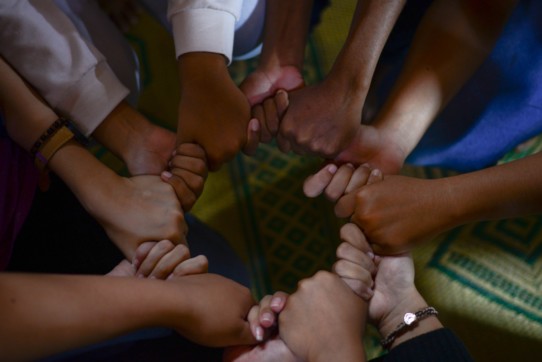A Guide to Exploring the Untapped Potential of Canada’s Multicultural Donors

If you ask Canadians what makes our country so special, many will point to its diversity. And our communities are becoming increasingly diverse; newcomers to Canada currently account for nearly 20% of the population, and by 2036, it is projected that as many as 1 in 3 citizens will be foreign-born.
Individuals immigrating to Canada bring distinctive experiences which enrich our society in so many ways. If there is any perception that newcomers to Canada are more likely to be beneficiaries of charitable services rather than donors, it would be a mistake to overlook these groups in your fundraising efforts.
Findings from a new study exploring the influence of ethnicity on supporting charities clearly highlight how critical it is for nonprofit leaders and fundraising professionals to understand and leverage donors from diverse backgrounds.
This research – Imagine Canada’s Multicultural and Newcomer Charitable Giving Study – probes the giving attitudes of newcomers to Canada and second-generation Canadians from six major population groups that have accounted for large proportions of newcomers to Canada in recent years (South Asian, Chinese, Afro-Caribbean / African, Filipino, Arab, and Iranian). As organizations look to diversify and broaden their contributor bases, the study and its findings can help guide the charitable and nonprofit sector on how best to engage these population groups.
The future of giving is diverse
Not only do multicultural Canadians tend to have quite positive views of giving and the role of charitable organizations, but they are also generous donors. The giving potential of these groups is enormous: as much as $1.7 billion could potentially be collected annually from the communities included in this study. A vast majority (74%) of respondents reported donating to charitable causes in the year prior to the survey, with an average gift of $857. As many as 58% of respondents said they believe they can give more. In addition, 39% said they would support more charities if asked more often, and 39% would like to support more charities but they don’t know how. And when asked about the reasons why they didn’t give more money, 9% of respondents indicated that no one had asked, while 8% said that they did not know where to give.
This clearly illustrates the untapped potential for charities and nonprofits. Despite representing a growing segment of the population, are organizations strategically reaching Canada’s newcomer and multicultural communities in their fundraising efforts? Keep reading to uncover key findings from the study which can help you build engagement and integrate multicultural donors into your fundraising strategy this year and beyond.
What motivates newcomers and second-generation Canadians to give?
Like any donor group, multicultural Canadians give for a range of personal reasons. A general trend emerging from the study indicates that newcomers and second-generation citizens are more motivated to support charities for intrinsic reasons such as satisfaction or showing compassion. However, the knowledge they have of a cause or organization is also an important factor, with about one third of respondents citing this reason as being ‘very important’ to them. Other frequently cited motivations for support include: helping one’s local community, helping Canadians in need, personal connection to a cause, and helping one’s ethnic community.
In contrast, these groups tend to not value extrinsic motivations, such as recognition or tax credits, nearly as much.
Which causes are they more likely to support?
Newcomers to Canada and second-generation Canadians are more likely to donate to some causes than others. The top supported causes reported among these groups are: hospitals, religious organizations, fundraising organizations and international development organizations.
The causes receiving a lower level of support include economic development & job training organizations, business & professional associations or unions, as well as advocacy or political organizations.
Another finding related to support for causes is important to note: the study shows that donation rates change over time. Those who have been in Canada the least amount of time are most likely to concentrate their giving on social services and universities & colleges while those who have been in Canada longer tend to give more to hospitals and religious organizations.
Which methods of giving are preferred?
44% of respondents donated using traditionally more single channel methods. Of these channels, newcomers to Canada and second-generation Canadians are more inclined to donate through in-person fundraising activities such as:
- Galas or sporting tournaments
- Being approached in a public place
- Through sponsorship of someone participating in an event such as a walkathon
- Door-to-door canvassing
With many of these activities disrupted by the ongoing pandemic, it is also critical to note that technology is playing an increasingly large role in donating – and these groups are no exception.
Over a third of respondents (37%) indicated that they made donations via a technology-based method. Donating through the organization’s website is the most common method, followed by using a mobile app or a more generic online method, social media appeal, email request and finally text/SMS, which is significantly less common. Another interesting finding: those who make technology-related donations make larger average donations than those who do not ($1,093 vs. $652).
Is advertising in the media effective?
Compared to other major channel types, donating in response to advertising or a media appeal is relatively uncommon, reported by just 16% of respondents. However, if we look more specifically at advertising in multicultural media, with effective messaging this channel may have the potential to significantly increase donations by helping charities reach newcomers who have recently arrived in Canada. The study shows that newcomers who have been in Canada for shorter periods have more positive views of charities using multicultural media.
When considering media for engaging multicultural Canadians, it is important to know that while the percentage of respondents influenced to donate by media appeals is comparatively small, the differences in average donation amounts are very considerable. Those donating in response to advertising contribute nearly twice as much as those who are not influenced by media appeals ($1,343 vs. $750).
Do holidays influence giving motivation among these groups?
Yes – holiday giving motivations are high among newcomers and second-generation Canadians. With the mainstream holiday season fast approaching, it’s worth knowing that respondents said their impulses towards giving are most likely to be affected by Christmas – and this is particularly true for individuals of Afro-Caribbean / African, Filipino and Chinese origins. Thanksgiving is also cited as a motivator to give for about a quarter of all respondents.
Traditional holidays likewise play a role in motivating multicultural Canadians to give. Respondents from Arab backgrounds also cited Ramadan, Eid al-Fitr, and Eid al-Adha as positive influences to give, while Iranians said the same of Nowruz. Over a quarter of South Asians said Diwali motivated them to give.
Are the behaviours of high-net-worth individuals different?
Some specific findings relating to high-net-worth individuals (defined as having at least $500,000 in assets, excluding the value of their principal residence) are worth considering when assessing or developing your outreach and fundraising strategy.
While this segment of individuals is more likely to give to virtually all causes and tend to distribute their donations more widely, the top causes they support include:
- Hospitals
- Religious organizations
- International development and relief
- Research
- Mental health
When compared to other donors, high-net-worth individuals are more likely to be motivated by tax credits, being asked by a family member, friend or colleague at work, being recognized for donating, and by promotional giveaways.
In addition, they are particularly likely to be influenced to donate by media appeals, and to support a cause via a monthly giving program. High-net-worth individuals may also be quite receptive to technology-based approaches: they are more likely to share charitable causes on social media and to strongly agree that they donate more often because of technology.
____
The survey’s findings highlight the generosity of multicultural donors and the massive giving potential that resides with newcomers to Canada and second-generation Canadians. Diverse donors can play an increased role in helping Canadian communities thrive if charities and nonprofits effectively engage and nurture relationships with these communities. To help you get started, download a free copy of the full report and watch the webinar Engaging Canada’s Changing Donor Landscape for additional findings and more.
The Multicultural and Newcomer Charitable Giving Study was conducted by Imagine Canada and Ethnicity Matters and was generously supported by Blackbaud Canada and a coalition of charities and nonprofits.

